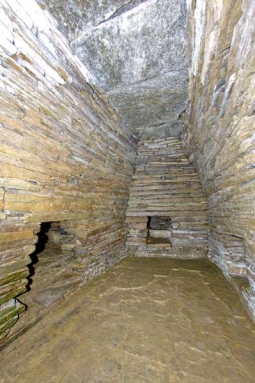Orkney's Chambered Cairns or tombs, are ubiquitous survivors from the Neolithic past. Widepread throughout the islands, visible as low, grassy knolls or mounds, these ancient constructions are generally thought to have served as burial places – or, more accurately perhaps, as Charnel Houses for the Ancestors.
Archaeologists in the past (and still today) have a tendency to describe anything remotely connected with death as a Tomb, and any construction not obviously functional as a place of Ritual. This simplistic approach ignores the complexity and diversity of human interaction no less valid 5000 years ago than it is today.
It seems obvious that these locations were in fact multiple focal points for the communities who built them, covering social, religious and tribal gatherings, functions and ceremonies. Certainly a very important element would have been as a funerary but no society can afford to invest the time and resources required for the construction of these remarkable places and not use them for diverse purposes. In addition, of course, secondary and not directly obvious or related activities will spring up in the vicinity as the inevitable consequence of human need.
The earliest Orcadian Cairns were built by the first farm settlers - people who appear in the historic record around the fourth millenium b.c., or six thousand years ago.
They are called Neolithic - new stone age - people and most assume they arrived from accross the pentland firth. It is certainly true that the knowledge of farming practices arrived in Britain following a circuitous 5000 year journey from the golden crescent around this time but whether the previous peoples, the Mesolithic or middle stone age, hunter gatherers simply developed farming techniques and consequently changed into sedentry communities or a new wave of migrants superceded them is pure conjecture.

The development of the chambered Cairn in Orkney spans thousands of years, during which time unsurprisingly a variety of different designs were adopted. Given our desire for classification of all things these designs are now generally seen as one of two main types - the Orkney Cromarty type and the Maeshowe type.
Of these the Maeshowe-type Cairns are unique to Orkney. The tombs have one main central chamber that is reached by a low, long entrance passage. One, or more, side chambers branch of from the main central chamber. They are practically more monumental in construction techinque than the stalled type chambered cairns.
Dating from around 3500 BC, the stalled structures represent the earliest phase of cairn development in Orkney and parallel the design of other early Neolithic buildings in the islands, the remarkable house at the Knap o' Howar on Papa Westray being very similar. They are also strongly associated with the shallow, round bottomed pottery described as Unstan Ware.Design of the cairns changed with developing stone building techniques. Maeshowe and Cuween represent the ultimate in Cairn development in Orkney,with design similarities to the houses of Skara Brae in Sandwick.
 By the time of Maeshowe, Unstan Ware had been replaced by the more ornate, flat-bottomed pots known as Grooved Ware. This process seems entirely normal. In addition to any internal functionality to the tribe or extended family who built the Cairns they would have also served a monumental informational purpose, defining territorial status and a powerful sign in the Land stating the health and wellbeing of the tribe, a message to the rest of the world that we are a strong and honourable people with strong and poweful ancestors.
By the time of Maeshowe, Unstan Ware had been replaced by the more ornate, flat-bottomed pots known as Grooved Ware. This process seems entirely normal. In addition to any internal functionality to the tribe or extended family who built the Cairns they would have also served a monumental informational purpose, defining territorial status and a powerful sign in the Land stating the health and wellbeing of the tribe, a message to the rest of the world that we are a strong and honourable people with strong and poweful ancestors.
This tribal totem aspect is possibly evidenced by the discovery of sea-eagle remains at Isbister in South Ronaldsay and the presence of multiple dog skulls at Cuween. The Dog Tribe and Eagle Tribe perhaps ? It is certainly true that the Cairns survival into the modern age is due in no small part to myth, fear and superstition. The widespread idea that they were the hollow-hills of trows and fairy-folk meant that the structures were generally avoided.
The Cuween Hill Cairn, Firth
The name "Cuween" derives from the Old Norse, "kúa-eng", meaning "Cattle Pasture". Like many other Cairns and mounds in Orkney, the Cuween Cairn was believed to be the home of trows or fairies. For many years the local name for the cairn was simply "The Fairy Knowe."
The Cuween Cairn is built into Cuween Hill, less than 10 minutes walk from Heddle. Although smaller than Maeshowe the cairn is in many ways an equally impressive feat of prehistoric engineering. Given the over subscription that Meashowe now suffers from it is perhaps a far more evocative and naturalistic site to visit than its more famous cousin a few miles to the west.
Built into solid bedrock, the Cairn comprises a main central chamber with four smaller chambers branching off from each wall. Access is by a low, narrow, entrance passage, which, being less than one metre high, requires the visitor to lose some poise and get down and crawl.

Once inside the main chamber is quite spacious and the visitor can stand comfortably - although in pitch black darkness. Historic Scotland provide a torch but the wise visitor should come pre-armed with their own light to guarantee not wasting the visit.
Thought to date from around 3,000 BC, the cairn was excavated in 1901. Partial remains of at least eight differant people were found inside. Aside from the human bones, the most interesting discovery was that of 24 dog skulls. They have been radiocarbon dated as contemporary with the human remains and unsurprisingly a variety of opinions abound as to the meaning and relevence of these curious canine skulls.
A few miles to the west is Maeshowe, a similar distance to the north-east on the side of Wideford Hill, is the Wideford Cairn, all constructed in the same era. The three Cairns are more or less in a straight line.
Near Maeshowe is the Barnhouse village, while the site of the Stonehall settlement, an extensive Neolithic village that predates the Knap o' Howar on Papa Westray is in the valley directly below Cuween Hill. Recent finds on Wideford Hill also indicate the presence of a probable settlement. These evocative Cairns were much more than tombs.










